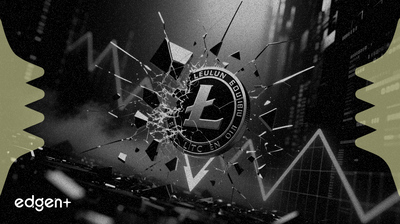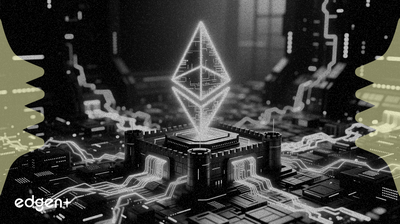 Report
Report
No Data Yet
Related News

Litecoin Plunges 34% As Correction Deepens
## Executive Summary Litecoin (**LTC**) experienced a significant price decline of over 34%, dropping to approximately $75 after failing to hold momentum above $113. This sharp reversal is not an isolated event but rather a symptom of broader fragility across the cryptocurrency market. Bitcoin (**BTC**) has also shown weakness, trading below key psychological levels as investors grapple with a complex macroeconomic environment. Technical indicators for **LTC** suggest the potential for a further correction, with analysts identifying a critical demand zone between $63 and $70. The event underscores a prevailing risk-off sentiment as the market weighs shifting monetary policies from global central banks and a change in market drivers from corporate treasury accumulation to exchange-traded fund (ETF) inflows. ## The Event in Detail Following a rally that saw its price climb to $113, **Litecoin** underwent a severe correction, erasing a significant portion of its recent gains. The price fell by more than 34% to establish a new local bottom around the $75 mark. This level is now under scrutiny by market participants, as technical analysis suggests it may not represent the end of the downward trend. According to market structure analysis, a deeper retracement is plausible, targeting a demand zone projected to be between $63 and $70. A failure to hold the $75 support could confirm this bearish outlook and extend the corrective phase. ## Market Implications The sharp sell-off in **Litecoin** serves as a barometer for growing risk aversion in the broader digital asset class. As one of the oldest and most established altcoins, its performance is often indicative of sentiment beyond **Bitcoin**. The move coincides with a market-wide state of "extreme fear," as described by sentiment indices. This bearishness is also reflected in **Bitcoin**'s recent performance, which has struggled to regain its footing after retreating from an all-time high of $126,000 to trade in the low $90,000s. The correction in a high-liquidity asset like **LTC** suggests that capital is flowing out of assets perceived as higher risk, a classic sign of a market shifting its focus from growth to capital preservation. ## Expert Commentary Market experts have pointed to a confluence of factors driving the current downturn. Markus Levin, co-founder of the blockchain company XYO, noted that sentiment indicators support "deeper corrective action." This view is reinforced by analysis from **Standard Chartered**, which has revised its **Bitcoin** forecast. Geoff Kendrick, the bank's head of digital assets research, stated, “We think buying by bitcoin digital asset treasury companies is likely over." He further argued that future price appreciation would likely be driven almost exclusively by ETF buying, indicating a structural shift in market demand. Adding a macroeconomic dimension, analysts are closely monitoring the **Bank of Japan (BoJ)**, which is expected to raise its policy rate to 0.75%. Historically, a stronger yen resulting from **BoJ** rate hikes has coincided with downside pressure on **Bitcoin** by tightening global liquidity. While some analysts believe the hike is already priced in, the precedent from a July 2024 rate hike, which was followed by a **BTC** slide from approximately $65,000 to $50,000, keeps investors cautious. ## Broader Context This market correction is occurring within a complex global financial landscape. While the U.S. Federal Reserve recently cut its benchmark rate, providing some liquidity, the **Bank of Japan**'s anticipated hawkish turn creates a divergent policy path that could unwind profitable "yen carry trades." For decades, investors have borrowed yen at low rates to fund purchases of higher-yielding assets, including cryptocurrencies. An unwinding of these trades could force the liquidation of those assets, adding further selling pressure. Furthermore, the narrative around institutional adoption is evolving. While corporate treasury accumulation, championed by firms like **MicroStrategy**, was a primary driver in the previous bull cycle, the market is now more reliant on inflows into spot **Bitcoin** ETFs. Data shows that while treasury companies have slowed their buying, ETF purchases are expected to continue. David Hernandez of **21Shares** noted that for prices to recover, "bullish momentum from the rate cut needs to overpower the concentrated short pressure" and that strengthening spot ETF inflows could be the "spark that transforms caution into momentum."

HashKey IPO To Test Hong Kong Crypto Market
## The Event in Detail **HashKey Group** is advancing with plans to launch an Initial Public Offering (IPO) in Hong Kong, positioning itself to become the first fully crypto-native company to go public on the exchange. The proposed offering will involve the listing of **240.57 million shares**. This strategic initiative is designed to fund the expansion of its comprehensive digital asset ecosystem, which extends well beyond a standard cryptocurrency exchange. HashKey's business model is built on providing an integrated, regulated financial services platform. Its operations encompass a wide array of services including a licensed spot exchange, secure custody solutions, institutional-grade staking, asset management, and the tokenization of real-world assets. By consolidating these functions, HashKey aims to serve as a one-stop shop for institutional and retail clients navigating the regulated digital asset landscape. ## Business Strategy and Market Positioning HashKey’s strategy is centered on a **"compliance-first"** approach, which distinguishes it from many crypto-native firms that have historically operated in regulatory gray areas. This positioning aligns with an emerging market trend where capital increasingly flows to trusted and transparent platforms. The significant net inflows into exchanges like **HTX**, which prioritizes asset transparency through **Proof of Reserves (PoR)**, underscore a market-wide demand for security and reliability. This strategy mirrors developments in other major financial jurisdictions, such as the recent approval of national trust bank charters for firms like **Circle**, **Paxos**, and **Fidelity Digital Assets** in the United States. While those firms are integrating into the U.S. banking system, HashKey is leveraging the public equity markets in Hong Kong to achieve a similar goal: cementing its status as a regulated, institutional-grade financial infrastructure provider. The move establishes a potential blueprint for other digital asset firms in Asia to seek legitimacy and capital through public listings. ## Market Implications The HashKey IPO serves as a crucial, real-time barometer of investor appetite for compliant crypto infrastructure. A successful offering would not only validate Hong Kong's ambitions to become a leading hub for regulated virtual assets but could also unlock a new channel for capital formation for the industry in Asia. It represents a shift from private venture funding to the public markets, signaling a new phase of maturity for the crypto sector. Conversely, a lukewarm reception could indicate that public market investors remain cautious, potentially slowing the move of other crypto-firms toward IPOs. The outcome will likely influence regulatory and corporate strategies across the region. ## Expert Commentary Market analysts and legal experts view 2025 as a formative period for crypto-related public offerings. **Laura Katherine Mann**, a partner at the law firm **White & Case**, has stated that 2025 will be a "test sample year" for such IPOs. She projects that 2026 will be the "true year of judgment," when the market will determine if digital asset companies are a viable long-term asset class. Mann’s commentary suggests that the next wave of companies going public will likely be focused on financial infrastructure, including regulated exchanges, custodians, and stablecoin platforms—a description that precisely fits HashKey's business model. However, she also cautioned that success will depend on disciplined valuations, macroeconomic conditions, and the price trends of crypto assets. ## Broader Context HashKey's IPO does not exist in a vacuum. It is part of a significant global trend toward the institutionalization and regulation of the crypto industry. Regulators worldwide are moving to establish clear frameworks for digital assets, reducing the legal ambiguity that has long hindered institutional adoption. The **U.S. Office of the Comptroller of the Currency (OCC)** greenlighting crypto firms as national trust banks is a landmark development in this regard, bringing digital asset custody and settlement firmly within the U.S. banking system's regulatory perimeter. This broader shift provides a favorable backdrop for HashKey's public listing. By embracing regulation, the company is positioning itself to capture the next wave of institutional capital entering the digital asset space. The IPO is therefore not just a corporate milestone but a significant event in the ongoing integration of crypto into mainstream finance.

Bitmine Commits to Hold, Stake 4% of ETH Supply
## Executive Summary **Bitmine**, a Nasdaq-listed investment firm, has publicly disclosed that it holds approximately 4% of the total **Ethereum** supply and does not intend to sell. Chairman Tom Lee announced the firm’s strategy to stake its holdings, projecting over $1 million in daily net revenue. This decision, substantiated by a recent $46 million acquisition of 14,959 **ETH**, marks a strategic shift in corporate treasury management, positioning **Ethereum** not merely as a speculative asset but as a productive, yield-bearing instrument. ## The Event in Detail According to Chairman Tom Lee, **Bitmine** has adopted a definitive long-term holding strategy for its substantial **Ethereum** portfolio. The firm’s position, constituting about 4% of the total **ETH** supply, will be actively staked to generate income. This strategy is projected to yield net revenues exceeding $1 million per day. This approach was further solidified by a recent transaction identified by blockchain analytics firm **Lookonchain**, where **Bitmine** acquired an additional 14,959 **ETH** for approximately $46 million. This move bypasses simple asset accumulation, directly leveraging **Ethereum’s** Proof-of-Stake mechanism to create a consistent revenue stream, treating the asset as a financial instrument with intrinsic yield. ## Market Implications The direct market consequence of a major holder like **Bitmine** committing to a no-sell and staking strategy is a material reduction in the liquid, tradable supply of **ETH**. This action is likely to increase scarcity and could establish a stronger price floor. Furthermore, large-scale staking enhances the **Ethereum** network’s security and stability. This strategy evolves the corporate treasury model established by companies like MicroStrategy with **Bitcoin**. While MicroStrategy’s approach is primarily a long-term hold against inflation, **Bitmine’s** strategy incorporates active yield generation native to the **Ethereum** blockchain, presenting a more complex and potentially more lucrative institutional use case. ## Expert Commentary Financial analysts view **Bitmine's** announcement as a powerful signal of institutional confidence in **Ethereum's** post-Merge economic model. The transition to Proof-of-Stake has been a key driver, transforming **ETH** into a yield-generating asset, which is a compelling thesis for institutional investors. This move is interpreted as a validation of **Ethereum's** fundamental utility as the foundational layer for decentralized finance (DeFi) and other blockchain applications. According to market observers, sophisticated investors are increasingly diversifying beyond **Bitcoin** to build strategic positions in other core blockchain assets that offer utility and yield. ## Broader Context **Bitmine’s** strategy aligns with a broader market trend toward the financialization of digital assets. This is evidenced by the recent filing for the **iShares® Staked Ethereum Trust ETF**, a product designed to offer investors exposure to both the price of **ETH** and its staking rewards through a traditional investment vehicle. Such developments indicate a growing demand for regulated, yield-bearing crypto products. This institutional adoption is further supported by regulatory advancements, such as the U.S. Office of the Comptroller of the Currency (OCC) granting conditional national trust bank charters to crypto-native firms like **Paxos** and **Fidelity Digital Assets**. This foundational work on regulatory clarity is critical for paving the way for wider and more complex institutional engagement with the digital asset class.

AI Data Center Anxiety Pressures Bloom Energy Stock
## The Event in Detail **Bloom Energy (NYSE: BE)** experienced significant selling pressure this week, with its stock price falling approximately 19.5% to close at **$94.98** on December 12. The decline was not linked to any direct corporate announcements but was instead a reaction to broader market anxiety concerning the pace and financial viability of the artificial intelligence data center expansion. Two primary factors drove the negative sentiment: 1. **Oracle’s Financials:** Disappointing results from key partner **Oracle** fueled investor debate about a potential mismatch between massive upfront capital expenditure for AI infrastructure and the timeline for monetization. The subsequent drop in **Oracle's** stock created a contagion effect. 2. **Reported Project Delays:** A media report, which **Oracle** later publicly denied, claimed that some data centers being built for **OpenAI** were facing delays due to labor and materials constraints. Although refuted, the report amplified existing market nervousness about the logistical and financial hurdles of building AI facilities at hyperscale. ## Business Strategy & Financial Mechanics **Bloom Energy's** strategic positioning is as a provider of fast, reliable, on-site power for data centers, bypassing slower grid-based solutions. This strategy has made its stock a high-beta proxy for the AI infrastructure boom. The company’s investment thesis is heavily dependent on major partnerships, most notably with **Oracle Cloud Infrastructure** and a **$5 billion strategic AI infrastructure partnership with Brookfield**. This week’s events demonstrate the double-edged nature of this strategy. When the AI narrative is strong, **BE** stock benefits from sentiment around power scarcity. Conversely, when partners like **Oracle** show signs of headwinds or the buildout narrative falters, **BE** stock is treated as collateral damage. Fundamentally, the company reported strong Q3 2025 results with **$519.0 million in revenue** (a 57.1% year-over-year increase) and a **non-GAAP gross margin of 30.4%**. However, the market is currently weighing this performance against the execution risk of its forward-looking pipeline. ## Market Implications The sharp decline in **Bloom Energy's** stock reflects a broader market recalibration. Investors are moving beyond pure narrative and are beginning to scrutinize the practical and financial realities of the AI buildout. The episode highlights that the market is becoming more selective, rewarding not just AI-related promises but also demonstrated, profitable execution. The focus is shifting toward tangible constraints, including power availability, construction supply chains, and the cost of capital required to fund these multi-billion dollar projects. For **Bloom Energy**, this means the company must convert its significant partnerships into durable, contract-backed revenue fast enough to justify a valuation that has priced in substantial future growth. ## Expert Commentary Wall Street consensus reflects deep uncertainty regarding **Bloom Energy's** valuation. Analyst ratings aggregated by MarketBeat show a consensus "Hold" rating. The 12-month price targets are exceptionally wide, ranging from a low of **$10** to a high of **$157**, with an average of **$93.77**. This divergence indicates a fundamental debate over the company’s business model. Bulls see a scalable "data center power platform," while bears see a lumpy, project-based company whose stock price has outrun its near-term contractual support. As noted by Barron's, at least one bearish analyst has argued that the company's valuation has stretched beyond its fundamentals, despite the powerful AI tailwind. ## Broader Context **Bloom Energy** operates within a fiercely competitive and evolving energy landscape. Big Tech firms are pursuing an "all of the above" strategy to power their data centers, including renewables, natural gas, and even long-term nuclear options. While **Bloom's** on-site fuel cells fill a critical gap for rapid deployment, they compete with other immediate and long-term solutions. Furthermore, the market is undergoing a "hydrogen reality check." As reported by Barron's and the Financial Times, enthusiasm for a clean hydrogen economy is cooling, with major players like **ExxonMobil** scaling back investments. This trend reinforces that **Bloom Energy's** near-term demand is primarily for natural gas-powered fuel cells, with its "hydrogen-ready" technology being viewed as a longer-dated call option rather than an immediate value driver.